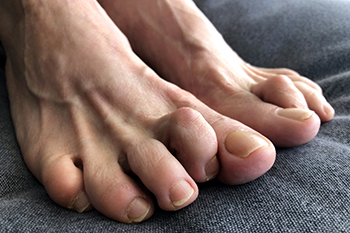
Hammertoe is considered to be a deformity. It is a foot condition that usually affects the 2nd, 3rd, or 4th toes, and causes them to bend downward at the joint. This can resemble a hammer, hence the name. Wearing shoes that do not have ample room for the toes to move freely may be a top reason why hammertoe occurs. Research has shown women are more prone to developing hammertoes and this may be the result of wearing high heels that have pointed toes. In the beginning stages, the toes may remain flexible and it is somewhat reasonable that they can be manipulated into their normal position. In more severe cases, corns may develop on top of the toes from friction as the toes rub that portion of the shoe. Additionally, there may be medical conditions that can lead to the onset of hammertoe, including rheumatoid arthritis, peripheral neuropathy, and inflammatory joint diseases. If you are afflicted with hammertoe, please consult with a podiatrist who can determine its severity and offer the correct treatment options.
Hammertoe
Hammertoes can be a painful condition to live with. For more information, contact Dr. Michael A. Wood from Foot Health Institute. Our doctor will answer any of your foot- and ankle-related questions.
Hammertoe is a foot deformity that affects the joints of the second, third, fourth, or fifth toes of your feet. It is a painful foot condition in which these toes curl and arch up, which can often lead to pain when wearing footwear.
Symptoms
- Pain in the affected toes
- Development of corns or calluses due to friction
- Inflammation
- Redness
- Contracture of the toes
Causes
Genetics – People who are genetically predisposed to hammertoe are often more susceptible
Arthritis – Because arthritis affects the joints in your toes, further deformities stemming from arthritis can occur
Trauma – Direct trauma to the toes could potentially lead to hammertoe
Ill-fitting shoes – Undue pressure on the front of the toes from ill-fitting shoes can potentially lead to the development of hammertoe
Treatment
Orthotics – Custom made inserts can be used to help relieve pressure placed on the toes and therefore relieve some of the pain associated with it
Medications – Oral medications such as anti-inflammatories or NSAIDs could be used to treat the pain and inflammation hammertoes causes. Injections of corticosteroids are also sometimes used
Surgery – In more severe cases where the hammertoes have become more rigid, foot surgery is a potential option
If you have any questions please contact one of our offices located in Lansing, and Chicago, IL . We offer the newest diagnostic and treatment technologies for all your foot and ankle needs.
